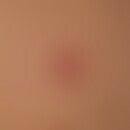Synonym(s)
HistoryThis section has been translated automatically.
DefinitionThis section has been translated automatically.
Rare, little inflammatory, superficial, peculiarly wire-like hard, strand-like, moderately painful phlebitis in the thoracoepigastric veins. Also possible in other localizations, such as the shaft of the penis in men. Mondor's disease is considered a special form of thrombophlebitis saltans.
You might also be interested in
EtiopathogenesisThis section has been translated automatically.
Pathogenetically it is a circumscribed, sclerosing thrombophlebitis of the subcutaneous thoracic veins of unknown cause. Described in connection with trauma, operations, infections, exertion, coagulation disorders. Cases after thermal ablation of varices have been observed.
ManifestationThis section has been translated automatically.
Occurs mainly in women between 30 and 60 years of age.
LocalizationThis section has been translated automatically.
ClinicThis section has been translated automatically.
Straight running, 0.2-0.3 cm thick, several centimetres long, hard, not or hardly reddened strand on the chest wall or in the armpit. Usually only minor subjective complaints: feeling of tension during movements and low sensitivity of the lateral thorax and the anterior axillary line. Spontaneous regression after a few weeks. After healing in the area of the previous lesion, sometimes persistent pressure pain.
HistologyThis section has been translated automatically.
Differential diagnosisThis section has been translated automatically.
TherapyThis section has been translated automatically.
Clarification and rehabilitation of any underlying tumour. Otherwise, the patient is informed about the relative harmlessness of the findings, which usually disappear within a few weeks. Anticoagulant ointments such as heparin or hirudoid ointment can be used as a support.
Some authors recommend anticoagulation with a low molecular weight heparin (e.g. 2.5mg Fondaparinux 1x/day for 45 days)
Progression/forecastThis section has been translated automatically.
LiteratureThis section has been translated automatically.
- Bartolo M, Bartolo M, Amoroso A, Bonomo L (1993) La malattia di Mondor. Osservazioni su 22 casi. Recenti Prog Med 84: 737-741
- Catania S et al (1992) Mondor's disease and breast cancer. Cancer 69: 2267-2270 Diamantopoulos EJ et al. (1999) Giant-cell arteritis presenting as Mondor's disease. Ann Internal Med 130: 78-79
- Holle-Robatsch S et al (2001) Mondor phlebitis associated with hepatitis C. Vasa 30: 297-298
- Mondor H (1939) Tronculite souscutanée subaiguë de la paroi thoracique antéro-laterale. Mem Acad Chir 65: 1271-1278
- Paes E, Rahmer H, Mitic B (1985) Mondor's disease. A casuistic contribution. Phlebol u Proctol 14: 133-134
- Zerweck C et al (2014) Morbus Mondor after endovenous laser ablation of the magna saphenous vein - a rare complication of endothermic varicose vein therapy. Vasomed 26: 215-216
Incoming links (11)
Coronary lymphangitis non-venereal; Iron wire phlebitis; Mondor, henri; Mondor phlebitis; Mondor syndrome; Phlébite en cordon de la paroi thoracique; Phlébite en fil de fer; Phlebitis; Sclerosing periphlebitis of the chestwall; String-shaped phlebitis; ... Show allDisclaimer
Please ask your physician for a reliable diagnosis. This website is only meant as a reference.







